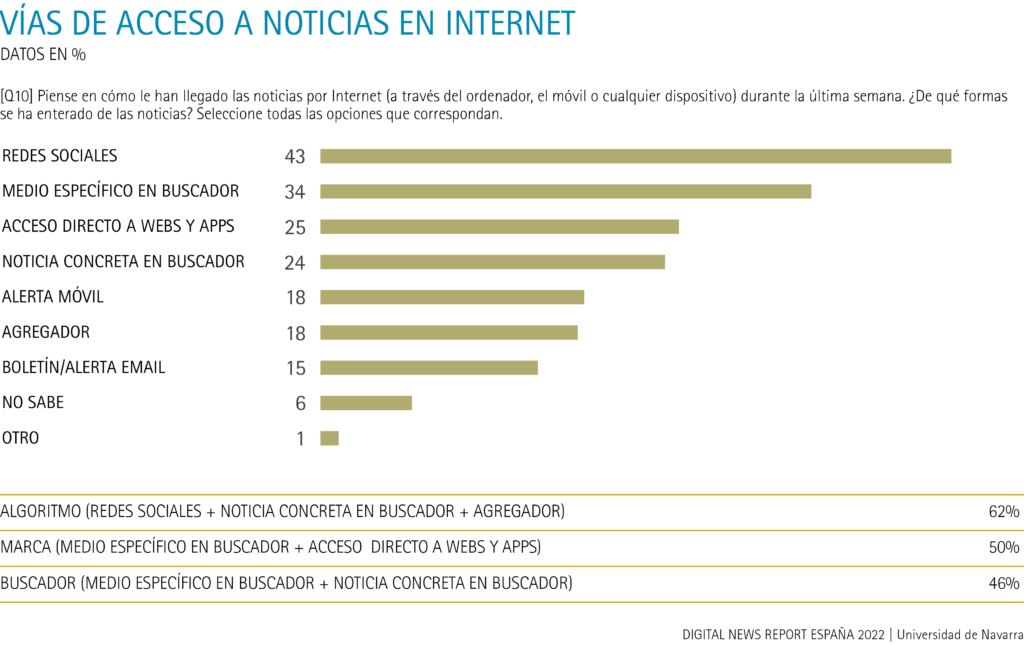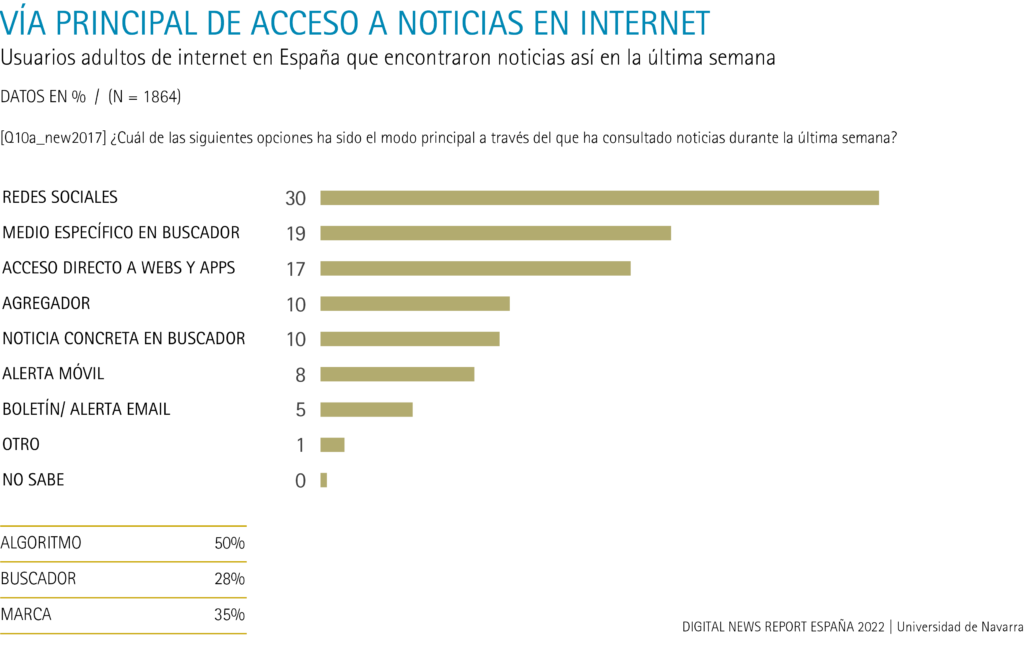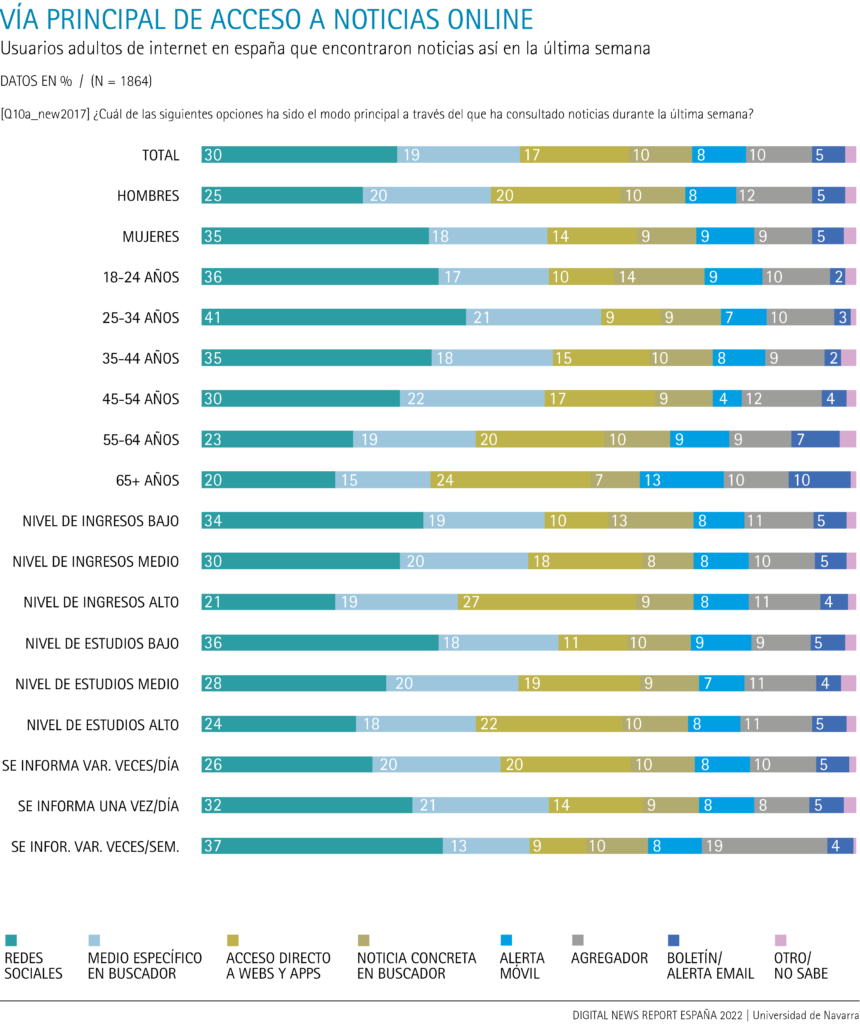-
Social networks are the main means of access to news for 35% of women (44% of those under 45), compared to 25% of men (31% among adults up to 44).
-
50% of users prioritize access through algorithms (social networks, 30%; aggregators, 10%; topic searches, 10%) over media branding (35%).
-
Less than 10% of users under the age of 35 mainly access journalistic websites and apps directly, although another 19% search for their brands on Google.
-
For every two users over 65 who enter the media mainly through social networks (20%), there is already one who does so mainly through email newsletters (10%).
Access to news through the platforms' algorithms continues to increase its advantage, which already stands at twelve points, over the itineraries of Username that start directly at the brands and media properties (50%), either because they have their apps installed, because they type their address in the browser, or even because they search for the name of the media on Google. In contrast to this loyal access to the brand to which only half of Internet users resort, social networks, search engines and aggregators together account for 62% of connected adults.
Specifically, the survey detects the year-on-year increase in the use of social networks to access news: at 43%, this is four percentage points more in 2022 than in 2021. Among adults under 45 years of age, the proportion is already 49%, compared to 40% above this age, even among those over 65. This channel is particularly popular among women, with 47% accessing news via social networks, compared with 39% among the men surveyed.
The adoption of aggregators is also increasing, with 18% in this edition, which is three points higher than in the previous survey . Unlike social networks, aggregators and personalized recommendation systems, such as Google Discover, Upday and others, are more popular among men (20%) than women (15%). You can read more details and learn more data about the use of specific aggregators in the next chapter.
Faced with the rise of technological intermediaries that offer a personalized experience, for yet another year there has been a stagnation or slight decrease in direct access to media websites and apps: with 25%, leave half a point compared to the previous year, although the internship of entering the name of the media on Google and accessing it through the first results has recovered by two points, to 34%. Therefore, half of the users access the news in one of these two ways, but this pathway through the brand name only reaches 45% of those under 45 years of age.

More searches by topic, same alerts and bulletins
If in the previous edition of this annual survey about 21% of users searched Google and similar services for specific topics and news for which they entered some words in the search boxes, this internship has risen to almost 24% in 2022.
On the other hand, there have been no variations, beyond a few tenths of a percentage point, in the channels that tend to be more minority or complementary to the previous ones, but which are an important part of the distribution strategy of the media today: push alerts to mobile devices (18%), and email alerts and newsletters (15%).
There are interesting variations by age. Push notifications or alerts are much more popular in the 18-24 age group (26%) and 55+ (23%), while among adults aged 25-54 they range from 12% to 14%. Apple has recently introduced improvements to its operating systems that help people who need to disconnect from informational notifications during the day to group or retrieve them at specific times from workshop.
pathway The information received periodically (newsletters) or punctually (alerts) via email has become a popular access to news, especially among older users: if only 9% of those under 45 years of age subscribe to news via email and enquiry, the proportion rises to 21% in the 55 to 64 age group, and 24% over the age of 65.
In terms of gender, there are no significant differences with searches by topic on Google and similar sites, nor with push alerts, but there are significant differences with information via e-mail, which reaches slightly more men (17%) than women (13%).

Prioritizing the algorithm over the brand
We now focus only on adult Internet users in Spain who encountered news in any of these ways in the last week, so the sample of the survey is reduced from 2028 total Internet users to 1864 people who had experienced any of these paths in the last seven days.
50% of these users prioritize access via platform algorithms (experiencing a sharp increase from 45% in 2021), compared to 35% who place more importance on accessing directly through the media brand (in 2021 it was 38%).
In detail, it mainly uses social networks 30% (three points more than a year ago); aggregators, 10% (two points more than in 2021), and searches by topics, expressions or words core topic allusive to the news (other than the names of the media), another 10% (up a few tenths compared to last year).
On the other hand, 19% of the respondents most frequently use search engine to enter the name of the media (one point less than in 2021), and 17% directly access websites and media applications (a decrease of just over one point compared to the previous edition).
The panorama is completed by two other channels that can be related both to specific media and to platforms outside them: alerts or push notifications (8% of active news users are primarily informed by them), andnewsletters or email alerts, which are the main means of access for 5% of consumers of current affairs via the Internet. In a context of information over-stimulation, notifications lose a few tenths of a percentage point year-on-year, and email, a point and a half, in percentage terms.

Preferred itineraries by gender, age and frequency
Social networks are the main way to find news for one in three women (35%), compared to one in four men (25%). In the age group of adults under 45, 44% of women use social networks more frequently than any other means of accessing news, compared to 31% of men.
Less than 10% of users under the age of 35 mainly access journalistic websites and apps directly, although another 19% enter their brands in search engines such as Google. In total, 27% of 18 to 24 year-olds, 30% of 25 to 34 year-olds, 33% of 35 to 44 year-olds, and around 39% above that age access through the media brand as a priority.
For every two users over 65 who access the media mainly through social networks (20%), there is already one who does so mainly through email newsletters (10%), and the highest adoption of push notifications or alerts as the main way to access news also occurs in this age group, with 13%.
The frequency of news consumption is crucial in the greater or lesser importance of the brand in accessing news: among those who get information several times a day, the brand still represents the main way of access (via media app, bookmark/favorite, or by typing the web address) in 40% of users, while those who get information once a day are in the general average of 35%, and for those who do not get information daily, but more than once a week, accessing news through the media brand is the main way only in 22% of cases.